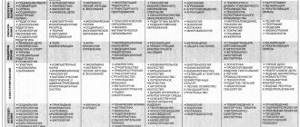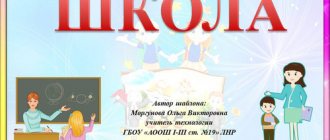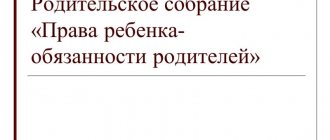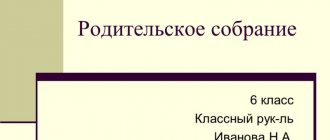Working with children of different ages (there are three in their twenties waiting in the lab) every day, I often encounter problems with attention. It’s difficult for the kids to concentrate and get into the task; they’re distracted by everything. A banal question from your desk neighbor: “should I write the number?” can throw you out of wise thoughts for a long time. And how often do students write answers to the wrong questions in problems... they asked the speed in kilometers per hour of a magician on a broom - they answered joyfully, “he flew 23 kilometers, and then the broom broke!”
It's funny, of course. True, when such answers are often found in exams, then it becomes very sad.
What to do about it? Work with care. Here I will give my favorite examples of the exercises that I use in practice, they can be easily modified for any age, increase complexity and track progress (be sure to do this, today give your child a form of one of the techniques and save the result, compare what will happen after a week of regular exercises ).
- The famous “find __ differences” pictures - time it (I usually time it 5 minutes) and give the child the opportunity to find all the differences in the pictures. After completing the task, it will be important for the preschooler to discuss in his voice what differences he found. There are a huge number of pictures on the Internet with this task, some are very simple, and there are those with which an advanced adult will suffer.
- Find-the-object games on your tablet/phone (limit your time!). These are interactive games with many small, hidden objects in one picture. And below it is written (or sometimes drawn) what needs to be found. Your task is to look carefully at the picture and finally find this hidden broom, with only the tip sticking out because of the ficus.
- The “listen” game - I use it with preschoolers, but for older children it is somehow irrelevant. We sit the children in a circle and ask them to close their eyes and listen carefully to what is happening around them. After a couple of minutes, everyone opens their eyes and shares what they heard.
- Game "Whose letter?" - also for little ones. We give each child a card with a letter (everyone has a different one) and begin to name small words familiar to the children (hare, mole, king, water, porridge...). If a child hears a word that contains “his” letter, he must do some action: jump, clap, etc. You can play with numbers in the same way.
- Mirror (at the same time we develop spatial thinking): the presenter shows the movements, they need to be repeated as the mirror does. The presenter waves his right hand, the mirror waves his left. And as long as we just raise our left hand, it’s easy. But try to cross your arms over your chest and cross your legs - and you yourself will get confused about how to do it).
- Lots of options for the “what has changed” game. In the simplest version, I ask the guys to make a shape like mine out of sticks. Then everyone honestly closes their eyes and I change something in it (add, delete, rearrange, change the color of the stick...). The task of children is to notice the changes and do the same for themselves. The coolest thing is that nothing can be changed. Then you can make more complex compositions, give them time to remember them and change something closed (or not change it). The task is to understand what has changed.
- We complicate the previous exercise a little more: we make some kind of composition from a bunch of different objects, give it a minute to remember this thing, close it and the student’s task is now to reproduce the same design from scratch.
- The game “I see so much...”. I give the children numbers on cards, their task is to find that many objects in the room in a minute. For example, here I see one window. Or I see 5 white chairs. Or 2 blue chairs.
- Exercise “cross out in different ways” according to the method of Nemov and Wexler. The child is given a sheet with different figures, and at the beginning there is a sample of what needs to be done with them: cross out the square diagonally, put a plus in the triangle, equal sign in the circle... The student’s task is to carefully, line by line, go through all the figures of the form and mark them like this , as stated in the assignment. This is a great exercise to incorporate into your work and can be used at the beginning of a lesson.
- The “find mistakes” exercise is convenient to do on the basis of texts from the Russian language or on simple mathematical examples (our task now is not to check mental arithmetic, but to train attentiveness).
- The famous and perfectly working Schulte table (there are tables of varying complexity). The student is offered a square with numbers scattered in it from 1 to... (here it depends on the complexity). The task is to find the numbers in order and show them as quickly as possible.
- “Proofreading test” technique. There are different varieties, but the essence is the same: to develop concentration and distribution of attention. To do this, the student is given a sheet with a bunch of letters mixed together (or, in other versions, coherent text, or text without spaces). The first task is to find one letter there and circle it in a certain way. This is a concentration task. Then you can make it more difficult: find 2 letters - cross out one of them and underline the other. Or make it even more difficult to 4, 5, etc. letters You can do the same with number sets, and for younger children there are worksheets with pictures.
- Munsterberg technique. This is a method for developing selectivity of attention. The child is offered a form with alphabetic material, among which he needs to look for words. For all of the above classical methods there are normative boundaries for each age, if you are interested.
- Smart tables. The questions and tasks in the table are simple, but there is a significant time limit (I give 2 seconds for each task, which teaches the child to make decisions quickly). There are many table options on the Internet; you can do it yourself, taking into account age and level. For those who are not familiar with the tables, there are tasks in the format “if dogs bark, put a plus in the triangle, if not, then draw a circle.”
- Working with long-term memory. The “time machine” game (oh, it’s also very useful for adults and very busy people). What did you have for breakfast yesterday, huh?



